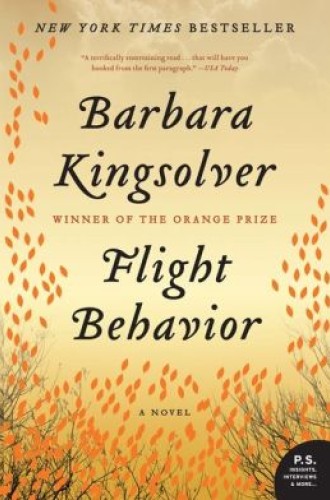Flight Behavior, by Barbara Kingsolver
On her way to a desperate assignation, an unhappy wife and mother is stopped in her tracks by a miracle: a mountain ablaze with color and motion, a fire without heat or sound. “Unearthly beauty had appeared to her, a vision of glory to stop her in the road.” Dellarobia thinks that “the burning trees were put here to save her.”
But the miracle that saves her from choosing loss and wreckage as an alternative to a dead-end life is no miracle at all for the monarch butterflies whose light and beauty are its source. Climate change has ruined the Mexican mountains that have been their wintering grounds from time immemorial and brought them to the foothills of southern Appalachia. Here they face almost certain extinction.
Read our latest issue or browse back issues.
Barbara Kingsolver’s novel is about the way Dellarobia’s life and the fate of the butterflies intertwine. Before Dellarobia’s father-in-law can sell the butterfly-covered evergreen trees to loggers, she brings the family up to see what they would be destroying. As the story of her discovery spreads, she becomes a celebrity in her church—the woman Spirit-led to witness a marvelous revelation. At this point it seems that the novel might be about the way a seeming miracle affects the faith and dynamics of a Southern congregation led by an able and compassionate pastor. Kingsolver’s depiction of that pastor, Bobby Ogle, is one of the most sympathetic clergy portraits in recent literature. But very quickly both pastor and church move to the periphery of the story.
The monarch phenomenon inevitably brings two groups of people to Dellarobia’s house and its surrounding mountains—serious scientists and sensation-seeking media representatives. Soon Dellarobia finds herself navigating between multiple disparate worlds: the world of the scientists, whose respect she must win as she begins to work with them on the butterfly project; the world of her neighbors, hard-working farmers struggling to survive while the larger world dismisses them as ignorant rednecks; the world of her own domestic life as an unhappily married mother trapped in the tedium of caring for young children in a household with scant resources; and the world of a media far more concerned with pleasing its audience than with telling the truth.
Part of Kingsolver’s purpose seems to be to shock us into recognizing how dire our environmental plight has become. She uses the monarch butterflies—which, in the real world, still follow their age-old migratory patterns and winter in their Mexican mountains—as an example of what is likely to be in store: environmental disasters and extinction of species.
Much of the novel is structured around the relationship between Dellarobia and Ovid Byron, the improbably named ecologist who comes to study and record what is happening to the butterflies. Byron discovers a good student in Dellarobia, and she finds a great teacher in him, as well as someone who has a thing or two to learn from her perspective. Their conversations, which sometimes come close to sounding like classroom lectures on Byron’s part, awaken Dellarobia to life’s possibilities, even while it shows her the precariousness of life on a planet with a steadily rising temperature. She learns that she has an aptitude for the careful lab work Byron hires her to do, and she discovers that they think the same way. Byron “did not claim that God moves in mysterious ways. Instead he seemed to believe, as she did, . . . that everything else is in motion while God does not move at all. God sits still, perfectly at rest, the silver dollar at the bottom of the well, the question.” Scientists are in the business of answering questions, all the while knowing that their work is always a process, that behind every answered question a new question waits.
Gradually Dellarobia becomes less of a listener and learner and more of a person with an opinion of her own. Byron’s contention that his job is only to weigh and measure, to track what is happening to the butterflies without offering any opinion about their plight or doing anything to help them, makes no sense to Dellarobia. “I’m not here to save monarchs,” he tells her. “That is a concern of conscience. Not of biology. Science
doesn’t tell us what we should do. It only tells us what is.” Dellarobia challenges him continually when he asserts that warning people about climate change is not his job and when he refuses to speak to the television anchor who is interested in the butterflies only as a light feature story. Gradually she influences Byron to speak out.
When she isn’t talking with Byron or working in his lab, Dellarobia is changing diapers, dealing with her difficult mother-in-law, trying to keep her threadbare house orderly, and struggling to live on her husband’s meager salary. She is stuck in a shotgun marriage to a man she neither loves nor respects, and she regrets her lack of an education or options. But she has a good mind, a lively way of talking, a smart young son and a witty best friend.
Still, there’s not much plot to keep this part of the story going. Accounts of trips to the secondhand store, of waiting for the school bus and of picking corn flakes off the carpet are not likely to keep readers riveted. Reading too much about tedium becomes tedious. Nor do these accounts prepare us for Dellarobia’s own abrupt flight at the end of the book.
Kingsolver’s book falls somewhere between environmental lecture and work of fiction. It succeeds best as a treatise on the effects of global warming and why we avoid acknowledging them. Presenting that knowledge through conversations between a talented teacher and a receptive student works well. But as a story about human interactions within a community, the novel falls short. Message trumps story.




